SVT. Career rifle
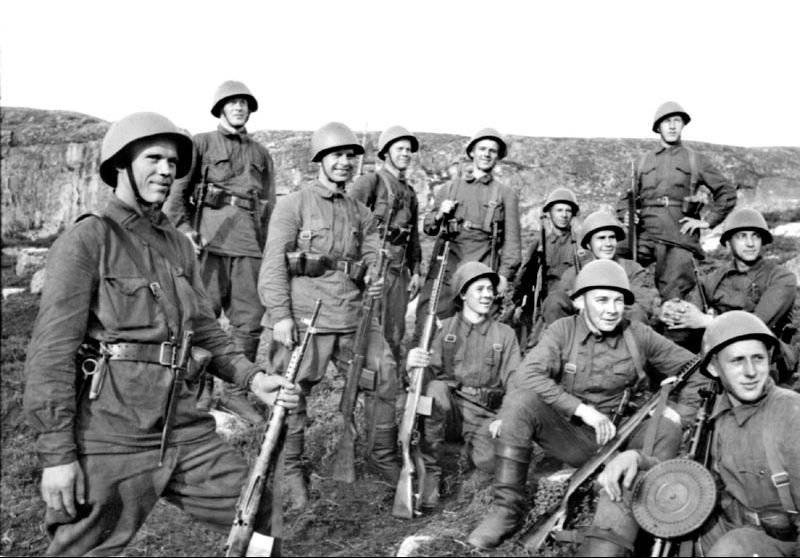
History weapons knows not so many examples of how a well-known and tested in harsh wartime sample receives very contradictory reviews. As a rule, the majority of specialists agree on one opinion or another and this system gets a fairly unambiguous assessment based on the rich experience of its combat use. But not always. A prominent representative of such a "controversial" weapon is the Soviet self-loading rifle SVT-40. It so happened that the lovers and experts of weapons in our country had not the most flattering opinion about it. And even more so this rifle was not included in the number of landmark, landmark. Not the last role in this was played by national weapon scientists - popularizers of weapon history, as well as specialized weapon editions. They, as a rule, avoided the topic of SVT-40 party, considering it not worthy of attention. Unsuccessful rifle - and that's it! And very few people tried to analyze the situation with this weapon, at least in the open press. And the situation, in our opinion, is not so simple. Of course, the rifle had inherent flaws due to the design and the fact that its mass production occurred during the difficult war years when more attention was paid to the solution of the quantity problem than to the quality problem. And yet, with all the flaws, she deserves a more respectful attitude.
First, not all of us who had to fight with SVT-40, agree with its negative assessment. Secondly, the rifle enjoyed considerable popularity among our opponents in two wars - the Finns and the Germans. And they can not be reproached either in the absence of qualifications in the field of weapons, or in a special love for all Soviet things. And, thirdly, we should not forget that on the eve of the Second World War, only the USSR and the USA were armed with self-loading rifles. No other state that had a highly developed military industry could solve this problem. Let us try to understand the reasons for the above-mentioned phenomenon and try to objectively evaluate the advantages and disadvantages of SVT-40.
The Tokarev self-loading rifle is one of the most controversial models in the history of Russian military weapons. The range of opinions about her - from the battle to the delight. On the one hand, traditionally it is believed that this system was too unreliable, cumbersome, sensitive to pollution, and therefore it was abandoned. On the other hand, a number of specialists, historians and users left the most positive feedback on SVT ..
The idea of making the “automatic” rifle for a rifle cartridge the main small arms of the army took shape and attracted many military men in the first decade of the 20th century (although various projects and even prototypes were created long before that time). By the time it was put into service, Fedor Vasilyevich Tokarev (1871-1968) had, perhaps, the longest experience of working on “automatic” rifles. The centurion of the 12 Don Cossack Regiment, a former gunsmith, he presented his first project in October 1908, while taking a course at the Officer Rifle School in Oranienbaum near St. Petersburg. Like most inventors, Tokarev began with a three-line magazine rifle. The automatics of his brainchild had to act on the principle of recoil of the barrel with a short stroke, the barrel bore was locked by turning the bolt, the store was permanent - it follows that the Tokarev’s first development cannot be considered as a prototype of CBT.
Approximately at the same period, the Commission on the development of a sample of an automatic rifle was created in Russia, and Tokarev's further work was already going on within the framework of this organization. The production base was Sestroretsky Arms Factory. A curious fact is that at the same time, V.A. Degtyarev, who helped Colonel V.G. Fedorov in the work on the rifle of his system. Over the past decade and a half, Tokarev has repeatedly reworked his system - in particular, he introduced locking with a swivel coupling. Finally, in 1914, the 7,62-mm rifle of the podlesaul Tokarev was recommended for military trials on a par with the experienced Fedorov and Browning rifles (this was already successful, although the 6,5-mm Rifle Fedorov had the greatest chances to get into service), but the war began. In 1915, Tokarev and several other inventors are recalled from the front. Soon, he asked for permission to continue work (this request, by the way, was supported by Colonel Fedorov), in the summer of 1916, in the rank of captain of artillery, he assumed the position of head of the inspection and assembly department of finished products of the Sestro rectsky plant and at the same time continued to improve his system. But the case is delayed. In July, 1919, the Civil War was in full swing, as a civilian engineer, Tokarev was sent to Izhevsk Arms Factory. Here, in addition to the main responsibilities for the release of magazine rifles, he is trying to bring his "automatic carbine." At the end of 1921, he was transferred as a designer-inventor to Tula.
Working at the weapons factory, and with the 1927 d -v Design Bureau (PKB) of hand weapons (later - SLE small arms), he creates an MT light machine gun (modified "Maxim"), a TT pistol, and prototypes of various weapons. But it does not leave the topic of an “automatic” rifle, especially since the interest of the customer — the military — does not cool down to this topic. Rejecting the developed BT. Fedorov of the concept of an automaton chambered for a different ballistic and geometry, the Red Army returned to the idea of an automatic rifle for a regular rifle cartridge.
At the 1926 competition, Tokarev presents a 7,62-mm rifle with automatic recoil-based barrel with a short stroke, locking swivel coupling, a regular 10 magazine for ammunition, a translator of fire modes, and in addition, 6,5-mm automatic rifles (at this time was still considered the issue of transition to a smaller caliber). At the next competition in June 1928, he demonstrates a slightly modified 7,62-mm sample and again receives a number of comments.
Beginning with 1930, another requirement was placed on automatic rifles: an automatic system with a fixed barrel (first of all, for the possibility of using a rifle grenade launcher). In March of the same year, Tokarev submitted for the contest an 7,62-mm rifle with automatic based on the removal of powder gases, with the location of the gas chamber under the barrel, with locking by turning the bolt, a permanent magazine for 10 cartridges.
It is worth remembering that in the same 1930, among other upgraded designs, a magazine rifle, arr. 1891 / 30 beer once again extended the career of the 7,62-mm rifle cartridge mod. 1908. In 1931, a Degatreva rifle was prepared for troop testing. 1930, but failed to bring it to the series, as the automatic rifle Simonov arr. 1931 d. Automatic rifles, in addition to the variable mode of fire, also acquired detachable stores, which made them close to the machine gun. Over the new system Tokarev worked with 1932 g. His self-loading carbine mod. The 1935 was released in a small series, but officially adopted a Simonov automatic rifle (ABC-36, its pilot production started back in 1934), although the main fire was considered to be single shots.
Since that time, F.V. Tokarev and S.G. Simonov became the main competitors in the creation of a new rifle. On the side of Simonov, a student of Fedorov and Degtyarev, there was a higher culture of design, while Tokarev, perhaps, took it with his experience and a certain authority, besides, his style of work was characterized by the introduction of permanent, sometimes drastic changes, even in those he experienced, but not completed system at the moment. Nevertheless, Tokarev finished his self-loading rifle. Of course, not alone - the design engineer N.F. Vasiliev, senior master A.V. Kalinin, design engineer M.V. Churochkin, as well as mechanics N.V. Kostromin and A.D. Tikhonov, fitter M.M. Promyshlyaev.
22 May 1938. By order of the People's Commissar of Defense and Defense Industry a new competition for a self-loading rifle was announced.
Among the general requirements for these weapons were high survivability in wartime conditions, reliability and safety of the mechanisms, the possibility of firing with all regular and surrogated cartridges. Self-loading rifles of the systems of S.G. Simonova, N.V. Rukavishnikova and F.V. Tokarev (all-automatics based on the removal of powder gases, detachable box-type magazines on 10-15 cartridges). The tests ended in September 1938 g, according to the commission’s conclusion, no sample met the requirements, but for such qualities as durability and reliability the Tokarev system rifle was allocated, which was apparently due to the quality of the production of prototypes. After making some changes to 20 in November, 1938 conducted repeated tests. This time his rifle showed the best results. And February 26 1939. The RKKA adopted the "7,62-mm self-loading rifle of the Tokarev system of the 1938 model g. (SVT-38)". In March, the inventor was awarded the Order of Lenin.
The adoption of the SVT-38 into service did not remove the question of choosing the best system - not everyone shared the opinion about the superiority of the Tokarevsky model. A special commission of the People's Commissariat of Armaments and the Main Artillery Directorate, comparing the modified Tokarev and Simonov rifles, gave preference to the latter in terms of mass, simplicity of device, time and cost of production, and metal consumption. Thus, the design of the SVT-38 included 143 parts, the Simonov rifle - 117, of which 22 and 16 springs, respectively, the number of steel grades used - 12 and 7. The then People's Commissar of Armaments (former director of the Tula Arms Plant) B.L. Vannikov defended the Simonov rifle. However, the decision of the Defense Committee under the Council of People's Commissars of the USSR of July 17, 1939 No. stopped further discussions in order to focus on the SVT, ready for rapid production. The day before, on July 16, the first serial SVT-38 was manufactured. The war was approaching, and the country's top leadership clearly did not want to drag out the rearmament process. SVT-38 was supposed to be the main rifle in the army. It was believed that a self-loading rifle in terms of fire power corresponds to two magazine ones, it allows you to fire on the move without stopping and without wasting time reloading. As early as June 2, 1939, the Defense Committee ordered the production of 50 SVT-38s this year; in 1940 - 600 thousand; in 1941 - 1800 thousand. and in 1942 2000 thousand.
At the Tula Arms Plant, a single design office for SVT-38 was created, and preparations for full-scale production were carried out in half a year, along the way, bringing drawings, defining technologies and preparing documentation for other plants. Since July 25 began assembling rifles in small batches, and from October 1-gross release. The assembly was organized on a conveyor belt with a forced rhythm - this was part of the introduction of mass production technologies into the weapons business.
The combat experience was not long in coming - the SVT went to the front already during the Soviet-Finnish war of 1939-40. Naturally, the new weapon required a number of improvements. Even before the end of the Finnish campaign by order of I.V. Stalin, who did not dismiss the course of work on rifles, established a commission chaired by the secretary of the Central Committee, G.M. Malenkov to address the issue of improving the SVT in order to "bring the Tokarev self-loading rifle closer to the Simonov self-loading rifle."
First of all, it was about reducing the mass of the CBT without sacrificing durability and reliability. The first required the relief of the cleaning rod and the store, but at the same time we had to slightly reinforce the box (it was made solid), change the metal casing of the barrel lining and install the cover of the forearm. Besides
In addition, for greater convenience of wearing and reducing the dimensions, the ramrod was moved under the barrel, the bayonet was shortened (according to Vannikova, Stalin, having received feedback from the Finnish front, personally ordered "to take the smallest, for example, Austrian"). In addition, a rather high sensitivity of the rifle to pollution, dusting and grease due to the relatively accurate, with small gaps fit parts of mechanisms. Eliminate all these claims without a major alteration of the system was impossible. Due to frequent complaints about the loss of a detachable store while moving, the requirement of a permanent store, which was not implemented in the series, once again surfaced. The store was apparently the main cause of repeated and later complaints about the "heaviness and cumbersomeness" of the CBT, although in weight and length it slightly exceeded the magazine rifle arr. 1891 / 30, which, incidentally, was laid in the conditions of the competition. With strict restrictions on the mass requirements for safety and reliability of work forced to perform many details of the mechanisms "on the limit."
13 April 1940. By a decree of the Defense Committee, the upgraded rifle was put into service under the designation “7,62-mm self-loading rifle of the Tokarev system. 1940 r. (SVT-40)”, its production began in July with the 1.
Externally, the SVT-40 differed in the metal casing of the forearm, the mounting of the cleaning rod, one false ring instead of two, a smaller number and increased dimensions of the muzzle brake windows. The weight of the CBT-40 without a bayonet was reduced compared to the CBT-38, by 0,3 kg, the length of the blade of the bayonet from 360 to 246 mm.
Tokarev in the same year 1940 was awarded the Stalin Prize, awarded the title Hero of Socialist Labor and the degree of doctor of technical sciences. Note that even now there was no cross on the Simonov system, as evidenced by this - that continued in 1940-1941. comparative tests of his self-loading carbines.
The Tula Arms Factory became the leading manufacturer of the SVT. According to the report of the People's Commissar of Weapons Vannikov from October 22 1940. submitted to the Committee of Defense, the serial production of the rifle began with 1 July of the same year. In July, 3416 units were manufactured, in August, already 8100, in September, 10 700. Izhevsk Machine-Building Plant began production of SVT-40, using the capacity released after the removal of ABC-36 from production. And at the Tula plant, which did not have its own metallurgy, and in Izhevsk, where its own metallurgy was at hand, as well as the experience of production of ABC-36, the organization of serial production of SVT cost many forces. New machines were required, the restructuring of the instrumental economy, the retraining of personnel, and, as a result, time and money.
20. Swivel swivel bottom of the butt rifle SVT-40 1944 release of the year
21. Lower swivel from the bottom of the rifle butt SVT-38
23. Simplified upper swivel on the top hoop ring of the rifle SVT-40
At the beginning of 1941, a commission headed by the Chairman of the Council of People's Commissars V.M. Molotov and with the participation of the main customers of the People's Commissar of Defense, SK Timoshenko, Chief of the General Staff G.K. Zhukov. People's Commissar of Internal Affairs L.P. Beria, solved the issue of ordering rifles for the current year. It was proposed to include in the order only self-loading rifles, but the active resistance of the People's Commissariat of armaments, conscious of the difficulties of rapid deployment of such production, made it possible to keep the magazine rifles in the plan and continue their production. The approved orders for 7 of February included I 1941 thousand rifles, of which -800 1 thousand self-loading (approved by the Council of People's Commissars of the USSR and the Central Committee of the CPSU (b) 100) (note that the release of 200 thousand pistols Shpagin guns - still representing auxiliary weapon).
SVT device
The design of the rifle includes several components: a barrel with a receiver, a vapor system and sights, a bolt, a trigger mechanism, a box with a barrel pad and a magazine. The barrel is equipped with a multislot muzzle brake and has a flood for mounting the bayonet. Automatic with a gas engine, a gas chamber with a pipe and a short stroke of the gas piston. Powder gases are discharged through a side opening in the wall of the barrel into a chamber located above the barrel, equipped with a gas regulator that changes the amount of exhaust gases. Around the circumference of the regulator are 5 holes of different diameters (the diameter is indicated on the lateral planes of the five-sided head of the regulator protruding in front of the gas chamber). This allows a wide range to adapt the work of automation to the conditions of the season, the state of the rifle and the type of cartridge. Gases entering the cavity of the chamber are fed along the longitudinal channel of the regulator to the tubular piston covering the nozzle of the gas chamber. A piston with a rod and a separate pusher transmit a pulse of powder gases to the bolt and return forward under the action of its own spring. The lack of constant communication of the gas piston rod with the bolt and the partially open top of the receiver allow you to equip the magazine from the holder.
The shutter consists of the core and the stem, which plays the role of a leading link. The charging handle is made integral with the stem and is located on the right. The barrel is locked by tilting the back of the gate body down. When the slide is rolled back, oblique grooves in the rear part of its stem, interacting with the side projections of the core, raise its rear part, disengaging from the receiver box. A hammer and a spring-loaded ejector are mounted in the bolt body, a return spring with a guide rod and a tube is inserted into the stem channel. At the other end, the return spring abuts the sleeve in the back of the receiver. The bushing serves as a limiter for the movement of the bolt back, a channel is drilled in it for the passage of the cleaning rod when cleaning the rifle. In the receiver mounted reflector with shutter stop. The stop stops the shutter in the rear position when the cartridges are used up.
The hammer-type firing mechanism is assembled on a detachable base (trigger guard), attached to the receiver from below. Descent - with a warning. When you press the trigger, its upper part pushes forward the trigger pull, which turns the yoke (whispered). The rocker frees the platoon, performed on the trigger head, and the trigger strikes the firing pin under the action of the helical combat spring. If the shutter is not locked, the self-timer keeps the trigger from turning. The uncoupler serves as a guide spring of the spring — when the trigger is turned forward, the rod depresses the trigger rod, lowers the thrust, its protrusion jumps off the ledge of the rocker arm, and the latter returns to the upper end forward under the action of the spring spring and is ready to seize the combat platoon of the trigger when the rolling system rolls back. Although it is considered more reliable disconnector, whose work is directly connected with the movement of the shutter, the scheme adopted in the SVT, works quite reliably and also quite simple. Safety valve lock is mounted behind the trigger and rotates in the transverse plane. When turning the flag down, it locks the trigger.
Food is produced from a detachable box-shaped metal store of sector shape with a staggered arrangement of 10 cartridges. A cartridge with a protruding sleeve made it necessary to take a number of measures to prevent the cartridges from clinging to each other when serving - the radius of curvature of the magazine box was selected, and the surface of the feeder was shaped so that the edge of each upper cartridge was in front of the bottom edge; protrusions holding the cartridges from axial mixing were made on the inner walls of the magazine case (in this store the CBT looked like a 15-charging store of a Simon rifle). Compared with SVT-38, the SVT-40 magazine is lightened on the 20 I. The grooves of the front part of the receiver cover and the large top window made it possible to load the magazine mounted on a rifle from the standard clip on 5 from rifle cartridges mod. 1891 / 30.
A cylindrical front sight with a safety catch is mounted on the muzzle of the trunk. The sectoral sight of the sector is cut to 1500 m with intermediate divisions corresponding to each 100 m. Note that the self-loading rifle went to a formal reduction of the targeting range, which many experts insisted on during World War I. The rifle is shot without a bayonet. The stock is wooden, solid, with a pistol protrusion of the neck and a metal nape of the butt, in front of the forearm the trunk and gas piston are covered with a perforated metal casing. There was also a wooden barrel pad. To reduce the thermal leash of the barrel and the heating of wooden parts, as well as to reduce the mass, through holes are made in the metal casing and in the receiver lining. Belts for belts are made on the butt and the ring of the belt. The bayonet is a blade, with one-sided sharpening and wooden lining of the handle, on the trunk it is fastened from below with a T-shaped groove, an emphasis and a latch.
Since sniper rifles at that time were created on the basis of conventional ones, the sniper version of the SVT was adopted. He is distinguished by a more careful trim of the bore and protrusion (tide) on the left side of the receiver for attaching a curved bracket with a PU 3,5-fold increase in sight (this scope was adopted specifically for the SVT rifle, and the 1891 / 30 rifle for a sniper rifle. adapted later). Fastening the sight was done so that it was not hit by a spent cartridges, flying out of the window of the receiver. The mass of SVT with a sight PU 4,5 kg. On the basis of the SVT was created n self-loading carbine.
It is well known that in 1939-1940. a new weapon system of the Red Army was formed. SVT - coupled with a Voevodin pistol, a Shpagin submachine gun (PPSh). heavy machine gun Degtyarev (DS) and large-caliber Degtyarev-Shpagin (DShK), anti-tank rifle Rukavishnikov - was to form a new system of small arms. From the above list, the pistol and PTR did not reach the series, the DS machine gun had to be discontinued due to technological lack of knowledge, and the DShK and PPSh, based on the existing production potential, proved to be excellent. SVT had its own destiny. Its main drawbacks were the impossibility of a rapid increase in production on the scale required by the war and the difficulty of quickly training replacements to handle such weapons.
25,26. CBT-40 fuses of various versions in the on position
28. Optical sight PU on rifle SVT-40. Left front view
War always causes an abrupt increase in the demand for weapons against the background of a sharp compression of the deployment time of the facilities, a reduction in the quality of materials and the average qualifications of the workers involved in the production, the rapid deterioration of equipment. The catastrophic development of events at the front only aggravated these factors for Soviet industry. Weapon losses were extremely high. On 22 June, the 1941 of the Red Army was generally provided with small arms (although in a number of western districts there was a lack of its stock). In the army there were 7 720 LLC rifles and carbines of all systems. In June-December, 1567 141 units of this weapon were made, 5 547 500 (i.e., about 60%) was lost, 98 700 (about half) was lost to submachine guns during the same period, and 89 665 was made. By January 1 1942 in the Red Army there were about 3 760 000 rifles and carbines and 100 000 submachine guns. In the equally heavy 1942, the 4 040 000 rifles and carbines came to the army, 2 180 000 was lost. On the losses of personnel during this period, arguing to these. But in any case, it was no longer a question of replenishing the troops, but in fact an urgent formation and arming of the new army.
The available reserves and mobilization reserves did not save the situation and therefore a return to the good old “three-line”, which was cheaper in production at 2,5 times and much easier, became more than justified. The refusal to expand the production of SVT in favor of the long-established magazine rifle and less complex submachine guns, in fact, under the conditions created, made it possible to provide the army with weapons.
Note that they refused not from the rifle itself, but from its role as the main armament. Production of SVT lasted as far as possible. In 1941, from the planned 1 176 000 conventional 37 500 sniper SVT-40, 1 031 861 and 34 782 respectively were made. From Tula, the production of SVT was evacuated to the Urals, to Mednogorsk, where during the first month they managed to collect 7000 rifles from the removed stock, and the break from the moment of the cessation of production in Tula to the beginning of its recovery in Mednogorsk was only 38 days. In January 1942, the production of Tokarev rifles was practically brought to the former "Tula" level. But when they fought for bringing the issue of SVT to 50 thousand per month. The Izhevsk plant has already received a task to issue magazine rifles up to 12 thousands per day (in the memoirs of the then Deputy People's Commissar of Armament VN Novikov, it was described what efforts the plant team had to make this by the end of summer 1942). The plan for 1942 has already assumed only 309 000 and 13 000 sniper SVT, it was released 264 148 and 14 210. For comparison - magazine rifles and carbines for 1941 were made 1 292 475, and in 1942 g. - 3 714 191.
According to the soldier’s tradition, SVT received the unofficial nickname “Sveta”, they began to ascribe a capricious female character to it. Complaints received from the troops were reduced mainly to the complexity of the rifle in the development, handling and care. The presence of small parts also caused a high percentage of failure of this weapon in connection with their loss (31%, while the store rifle model 1891/30, of course, was much lower, only 0,6%). Some aspects of working with SVT were really difficult for mass weapons. For example, the rearrangement of the regulator required the use of a key and was quite painstaking: to separate the store, take the bolt back and put it on stop (lifting the stop with a finger through the receiver window), remove the ramrod, remove the left ring, separate the metal casing, and retract the gas piston with the key turn the nozzle half a turn, install the required edge of the regulator nut horizontally at the top and fix the nozzle with a key, release the piston, close the shutter, put on the cover, put on the left ring, insert the ramrod and magazine. The condition and accuracy of the regulator installation required constant attention of the user. However, in general, CBT required only careful care to ensure reliable operation and an understanding of the basics of work to quickly eliminate delays. That is, the user must have had some technical training. Meanwhile, back in May 1940, the People's Commissar of Defense S.K. Tymoshenko, taking things from K.E. Voroshilov, wrote down, among other things: "a) the infantry is weaker than the other combat arms; b) the accumulation of the prepared infantry reserve is not enough." By the beginning of the war, the level of training had not grown significantly, and even the majority of those who had been in military service did not know the device of the SVT. But they were lost in the first six months of fighting. Replenishment was even less willing to exploit such weapons. The guilt of an ordinary soldier is not in this. Almost all recruits who are more or less familiar with technology were selected in tank and mechanized troops, artillery, communications troops, etc., the infantry received mainly replenishment from the village, and the terms for preparing soldiers for the "Queen of the Fields" were extremely short. So for them the "three-line" turned out to be preferable. It is characteristic that naval infantry and naval infantry brigades remained faithful to SVT throughout the war - more technically competent youth were traditionally selected for the fleet. The CBTs worked quite reliably in the hands of trained snipers. For the majority of the partisans, the SVT left by the retreating army or repulsed by the Germans caused the same attitude as in the rifle units, but the trained NKVD and GRU groups preferred to take sniper SVT and automatic AWTs into the enemy rear.
A few words about these modifications. Sniper rifles accounted for only about 3,5% of the total number of issued SVT. They were removed from production with 1 October J '1942, resuming the release sniper-I Persian rifle. The accuracy of firing SVT was worse in 1,6 times. The reasons were in the shorter barrel length (it caused a larger muzzle flame), imbalance due to movement and impact of the moving system before the bullet flew out of the barrel bore, the barrel and receiver were displaced in the box, and the scope bracket was not rigidly fixed. It is worth considering the general advantages of store systems over automatic ones in terms of sniper weapons. Head of GAU N.D. Yakovlev talked about "a certain craftsman" on the Western Front, which was already in the autumn of 1941. I converted my SVT into an automatic one (in Vannikov’s memoirs, this episode is related to 1943). Stalin then ordered the author to be rewarded for a good offer, and to punish him with a few days of arrest for unauthorized alteration of weapons. Here, however, something else is interesting - not all front-line soldiers "were striving to get rid of self-loading rifles," some even looked for a way to increase their combat rate of fire. 20 May 1942. The decision of the State Defense Committee of the USSR to launch the production of the previously deferred AVT-40 took place - from July it went into the army. For automatic firing, the fuse in it turned further, and the bevel of its axis allowed for a greater shift back of the trigger - there was no disconnection of the trigger from the rocker of the trigger and the shooting could continue as long as the hook was pressed and there were cartridges in the store. SVT were converted into 1942 in the automatic and in the military workshops. Experts of the State Agrarian University and the People's Commissariat of Weapons were well aware of the low accuracy of shooting with bursts of rifles (it was also detected at ABC-36), and that with a relatively light barrel the rifle loses its ballistic properties after the first long line, and that the strength of the receiver CBT boxes are insufficient for automatic shooting. Adoption of the AVT was a temporary measure designed to increase the density of fire at 200-500 m ranges with decisive light machine guns at decisive minutes of the battlefield, although of course they could not replace the ABT and ABC light machine guns. The accuracy of the shooting of the AVT-40 was inferior at the 200 range and the accuracy of, say, the PPSh submachine gun — if the ratio of the muzzle energy of the bullet to the weapon’s mass was about 172 J / kg, then uAVTiSVT-787 J / kg.
The question of mass automatic individual weapons was by no means asleep, it was only decided at the expense of submachine guns, again much cheaper and easier to manufacture and quickly mastered by the fighters.
During the war years in the USSR, 12 139 300 rifles and carbines and 6 173 900 submachine guns were launched. In this case, the general release of conventional SVT-40 and AVT-40 in 1940-1944. made more than I 700 000, sniper - more 60 000, and most of them are made in 1940-41gg. Fully production of conventional SVT was terminated only in accordance with the order of 3 of the GKO USSR of January 1945. It is unlikely that a really “useless” sample would remain in production at all for such a time.
Vt Fedorov, who generally responded positively about the works of Tokarev, wrote in 1944: "With regard to the number of self-loading rifles, the Red Army stood above the Germanic war by the beginning of World War II; unfortunately, the quality of the SVT and AVT did not meet the requirements of the combat situation." Even before the introduction of the SVT into service, such major specialists as VT. Fedorov and A.A. Blagonravov pointed to the reasons that complicate the creation of an effective automatic rifle - the contradiction between the presence of the automation system and weight restrictions, the excessive power and weight of the cartridge - as well as the reduction of the role of rifles in mid-range shooting and long-range development of light machine guns. The experience of the war confirmed this. Only the adoption of an intermediate patron — about which Fedorov also wrote — enabled it to satisfactorily solve the problem of individual automatic weapons. You can say that with 1944g. There were no further prospects in the armament of our army not only for the SVT, but also for other rifles (except sniper rifles) or carbines for a powerful rifle cartridge.
Very interesting attitude to the SVT from the enemy during the war. In the famous painting by A. Deineka "Defense of Sevastopol" with SVT in their hands are depicted not only Soviet sailors, but also Wehrmacht soldiers. The painter, of course, may not understand the weapon, but in this case, he unwittingly reflected reality in some way. Lacking small arms, primarily automatic, the German army widely adopted trophy figures as a "limited standard." So, captured SVT-40 received the designation "Selbstladegewehr 259 (g)" in the German army, sniper SVT - "SI Gcw ZO60 (r)". But German soldiers and officers actually used our SVT willingly when they could stock up on ammunition. The “Russian semi-automatic rifle with a telescopic sight” was, for example, among the “best weapons” in counter-offensive teams. They say the best form of flattery is imitation. Failing to fine-tune the G.41 (W) Walter and G.41 (M) Mauser self-loading rifles, the Germans adopted the 7,92-mm G.43 armed with the strong influence of the Soviet SVT in the middle of the war, short stroke piston, detachable magazine, tide under the telescope bracket. True, G.43 and its shortened version of K.ag.43 in the German army also did not become particularly widespread. In 1943-1945 released around 349 300 conventional G.43 and 53 435 sniper G.43ZF (13% of the total number - the Germans attached greater value to self-loading rifles with a telescopic sight) for the same period around 437 700 assault rifles under the "Kurtzpron". The apparent influence of SVT can be seen in the post-war Belgian self-loading rifle SAFN М49, which was in service in a dozen countries.
Often, listing the shortcomings of the SVT, they cite as an example the successful experience of the Americans 7,62-mm self-loading rifle Ml of the J. Garand system, which has earned a good reputation and military glory. But the attitude towards her in the troops was ambiguous. Former paratrooper General M. Ridgeway, comparing the Garand with the shop-building Springfield, wrote: "With Springfield I can act almost automatically, but with the new Ml I somehow am not sure of myself." Americans, by the way, spoke about SVT-40 not bad.
So, the reason for the curtailment of the production of SVT and the sharp drop in its role in the weapon system was not so much the design flaws as the problems of increasing production in difficult conditions of war and the complexity of operating under-trained fighters. Finally, the era of massive military rifles for powerful cartridges was just ending. Had it been accepted on the eve of the war instead of the SVT, say, a Simonov rifle, she would surely have suffered the same fate.
The experience of the war forced to speed up work on a new cartridge and a new type of individual automatic weapon, an automatic, to radically change the approaches to the design and technology of its production. After the Great Patriotic War, the remaining SVT, along with other weapons, were supplied abroad, in the USSR the Tokarev self-loading rifle was used in the guard of honor, in the Kremlin regiment, etc. (it should be noted that here it was later replaced by the Simonov self-loading carbine of the system).
Incomplete disassembly of SVT-40:
1. Disconnect the store. Holding the weapon in a safe direction, pull back the bolt, examine the chamber and make sure that there is no cartridge in it, release the bolt handle, pull the trigger, turn on the fuse.
2. Feed the receiver cover forward and, holding the return spring guide rod from the bottom to the bottom, separate the cover.
3. Having pushed forward the guide bar of the return spring, release it, lift it up and remove it together with the return spring from the bolt.
4. Pull the stem of the bolt back by the handle, move it up and remove the bolt from the receiver.
5. Separate the skeleton of the bolt from the stem.
6. Pressing the ramrod latch (under the barrel muzzle), remove the ramrod; click on the locking ring ring (bottom), remove the ring forward.
7. Pull the metal cover of the barrel lining forward, lift and separate from the weapon. Separate the wooden receiver plate, moving it back and up.
8. Pull the stem back until it comes out of the gas piston bushing, lift the stem up and out. Separate the gas piston.
9. Use the wrench from the accessory to unscrew the gas fitting, press the gas regulator in front and remove it.
10. Using a key, unscrew the front hub of the muzzle brake and separate it.
Reassemble in the reverse order. When assembling, pay attention to the exact position of the gas regulator and the coincidence of the grooves of the receiver cover with the projections and grooves of the return spring guide rod.
39. The self-loading Tokarev 1940 carbine with a telescopic sight, specially made as a gift for TOZ K. K.E. Voroshilov


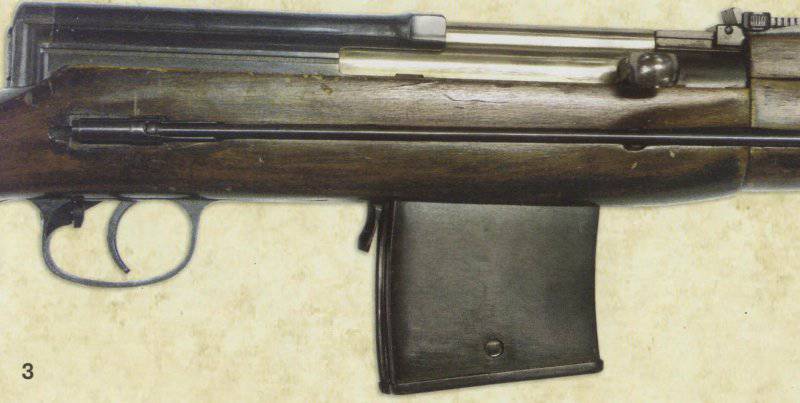
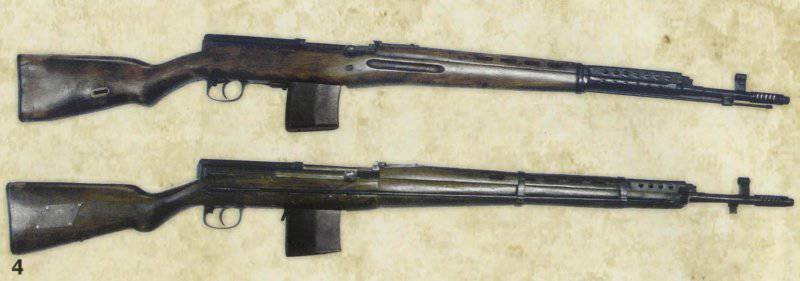
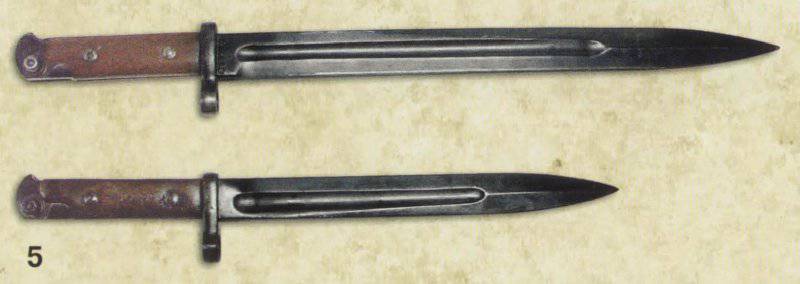




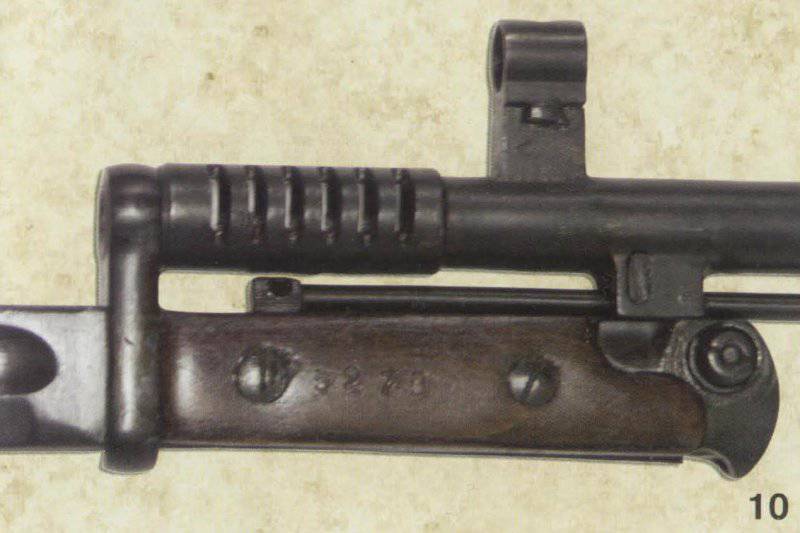
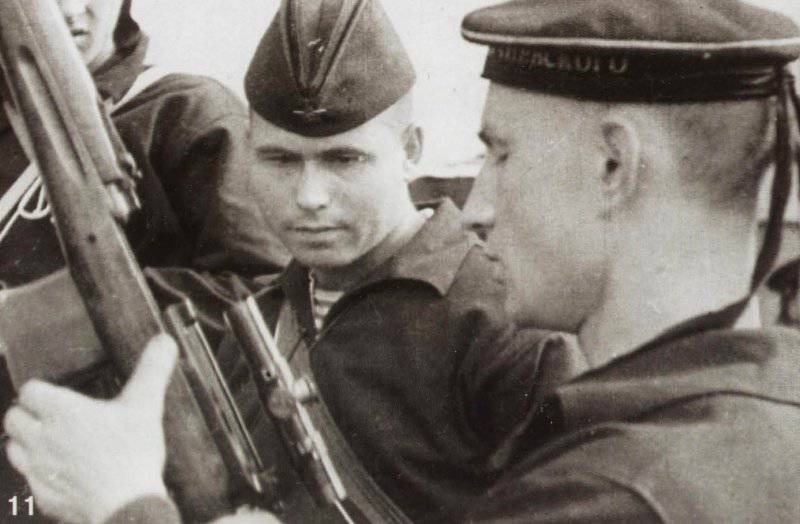
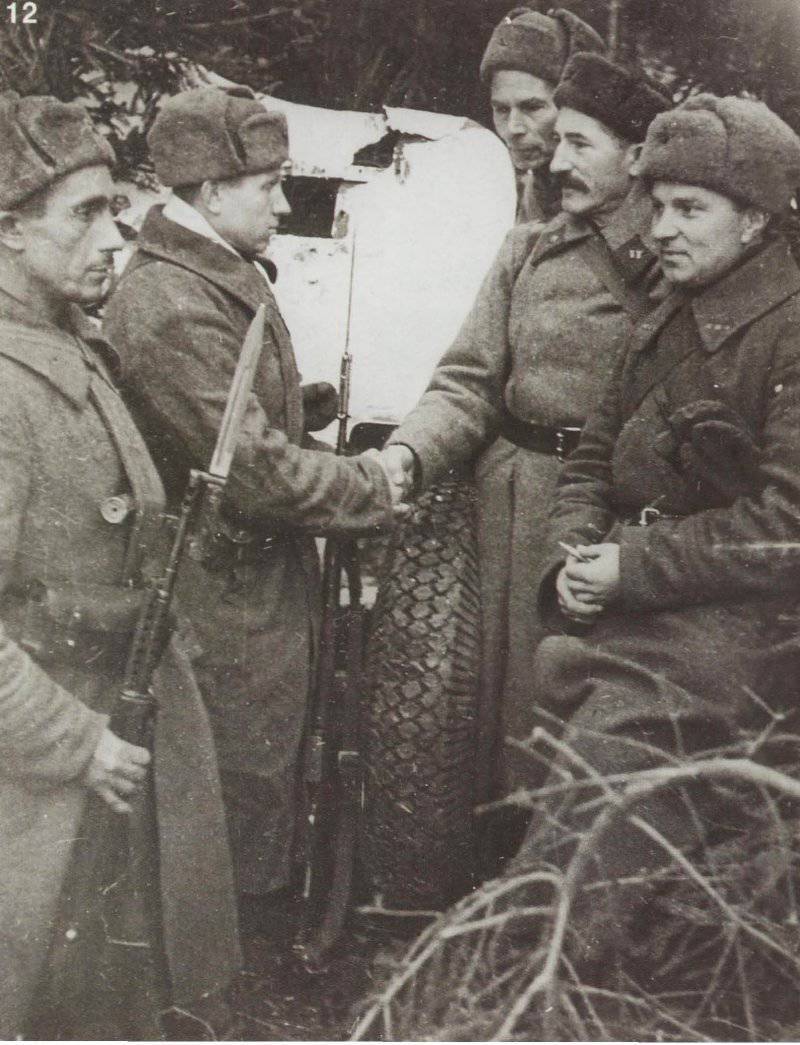
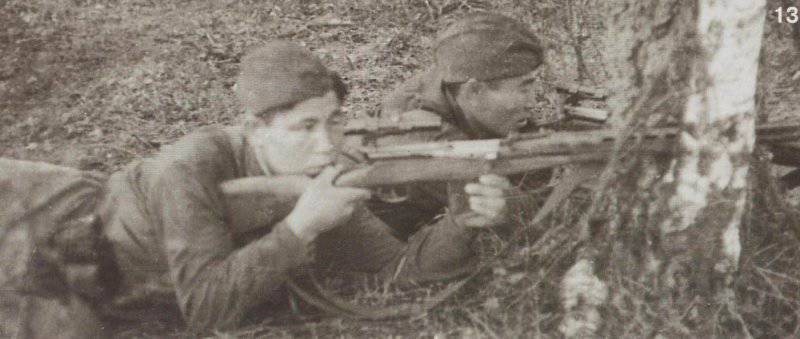
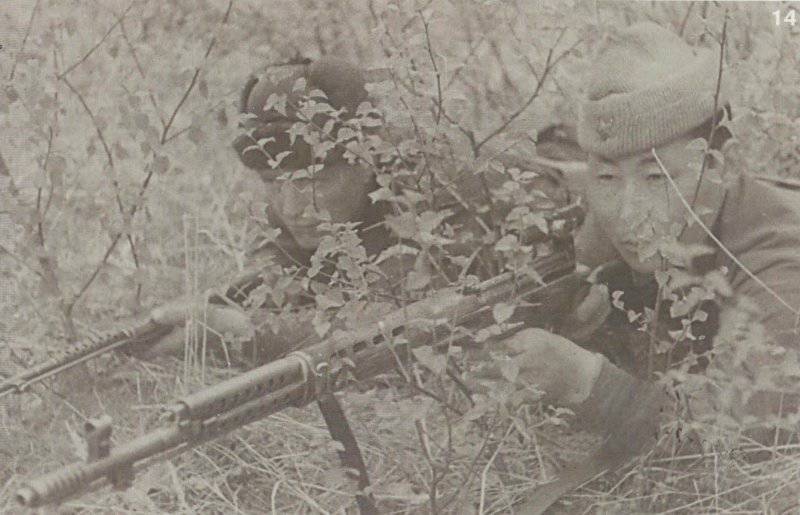
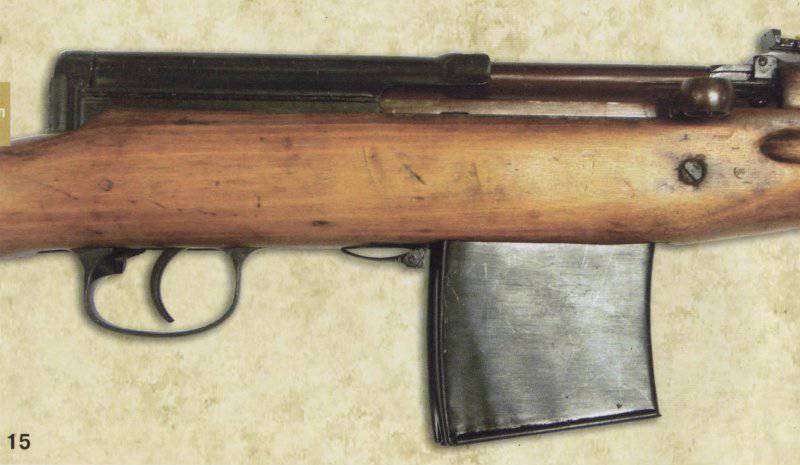
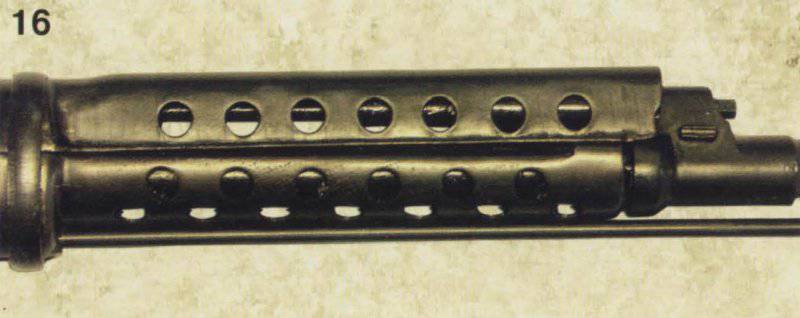
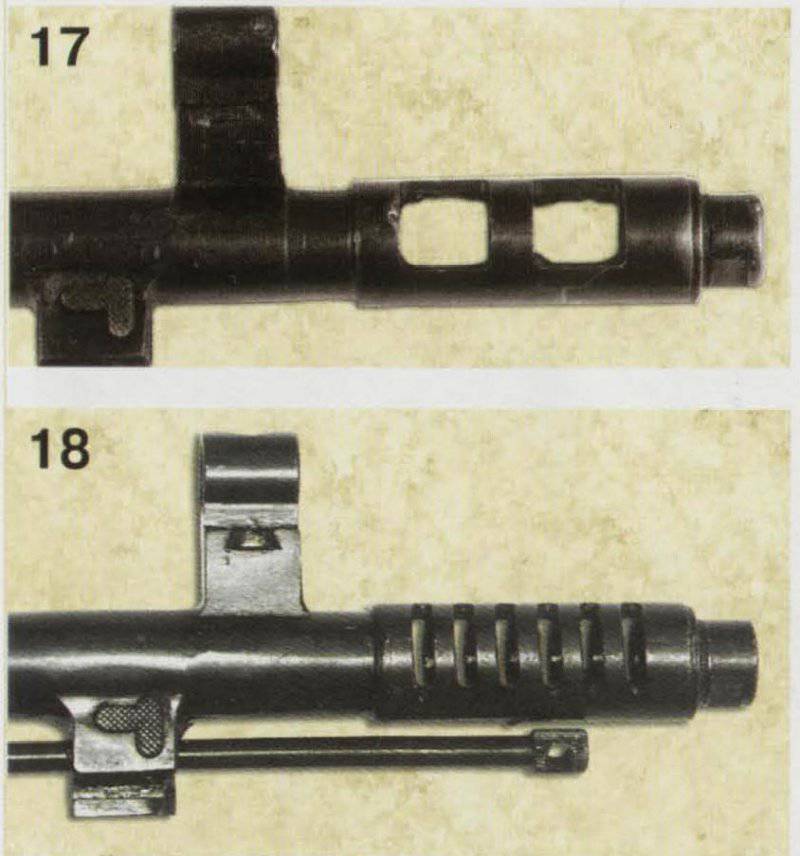
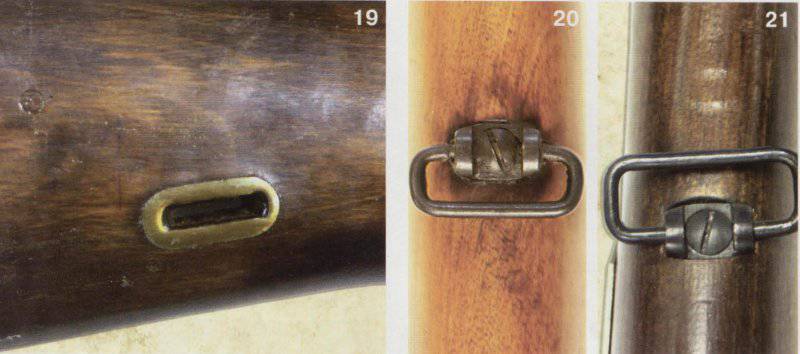
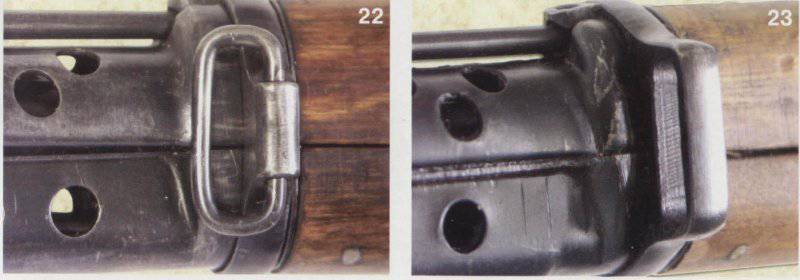
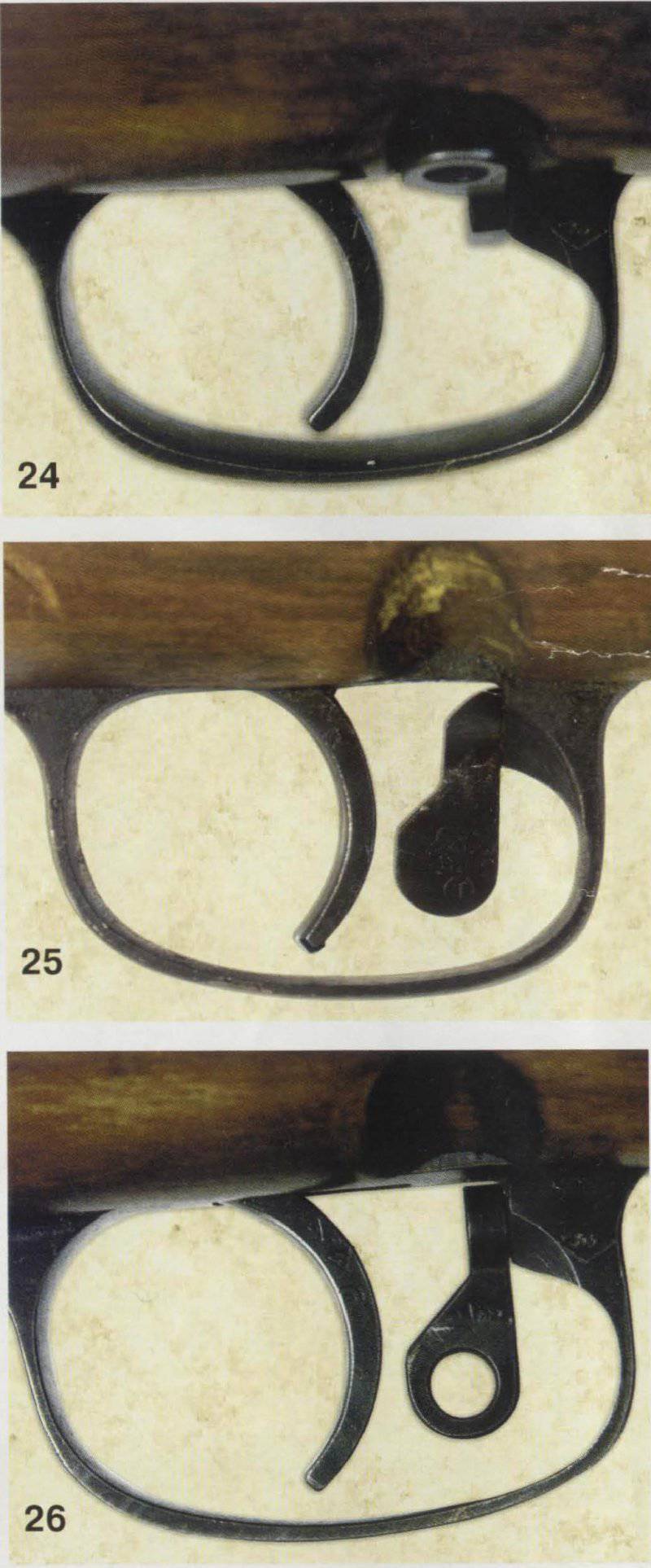
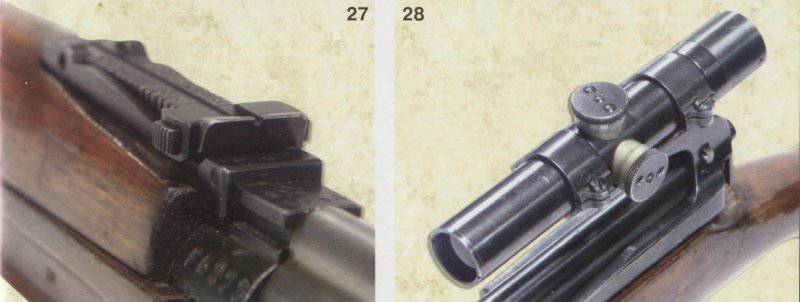
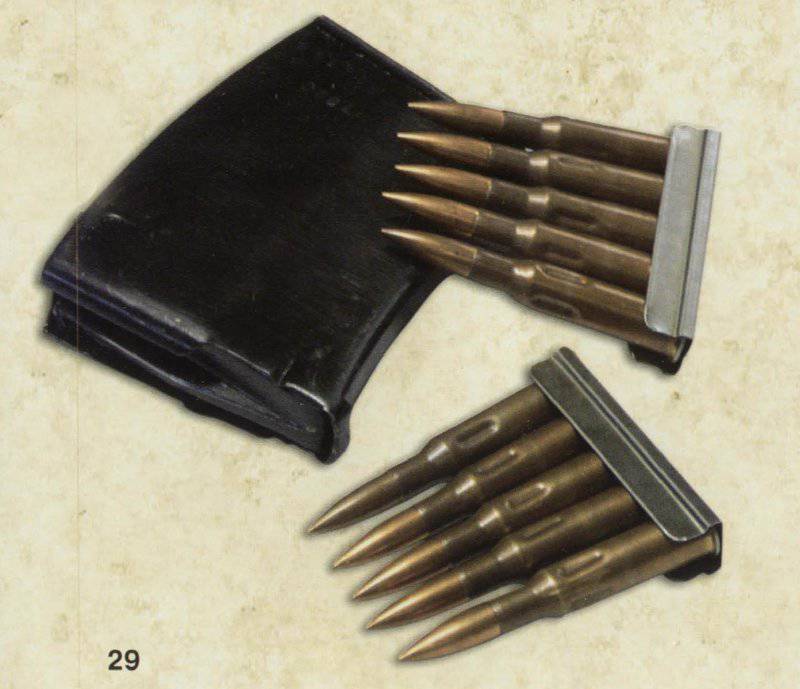
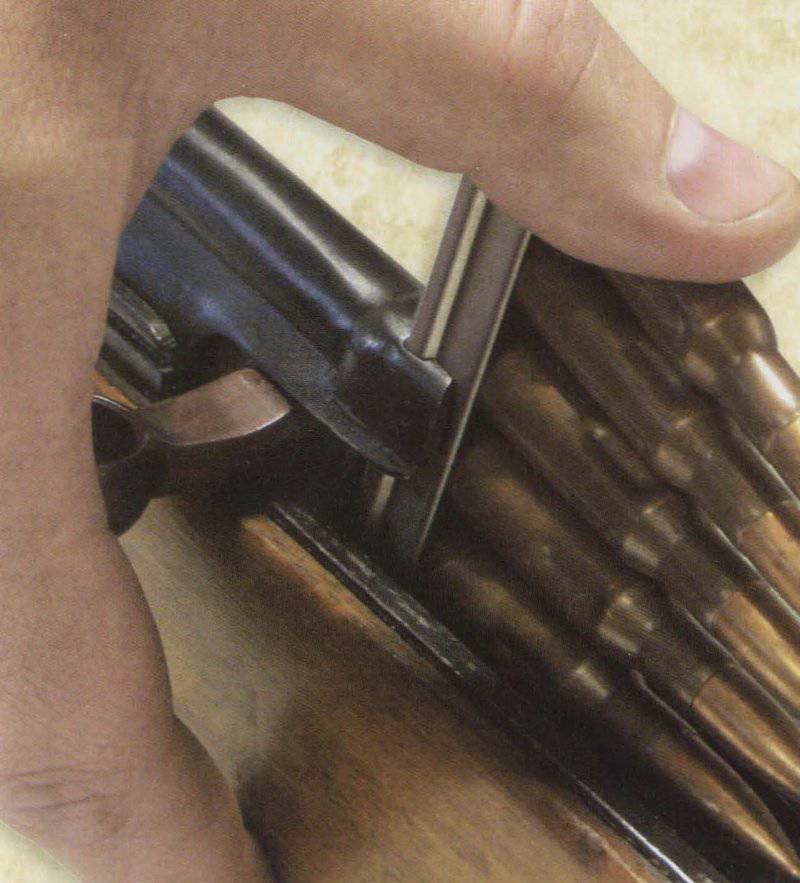
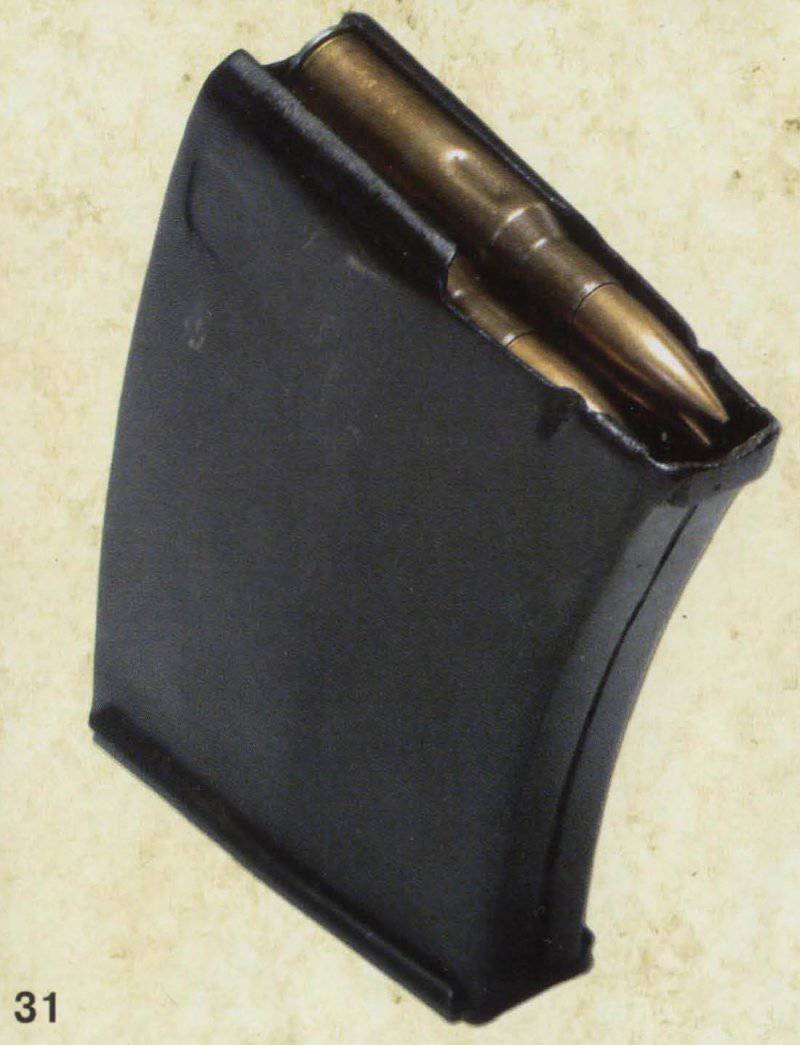
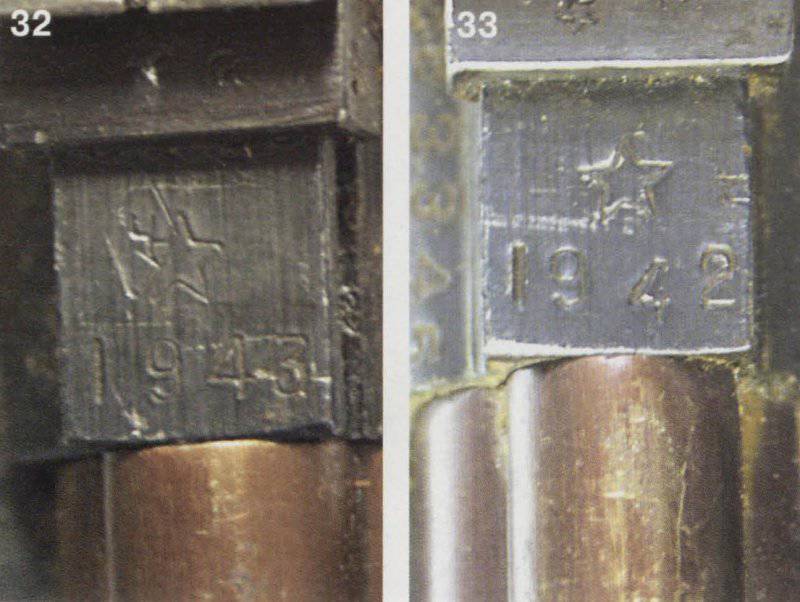
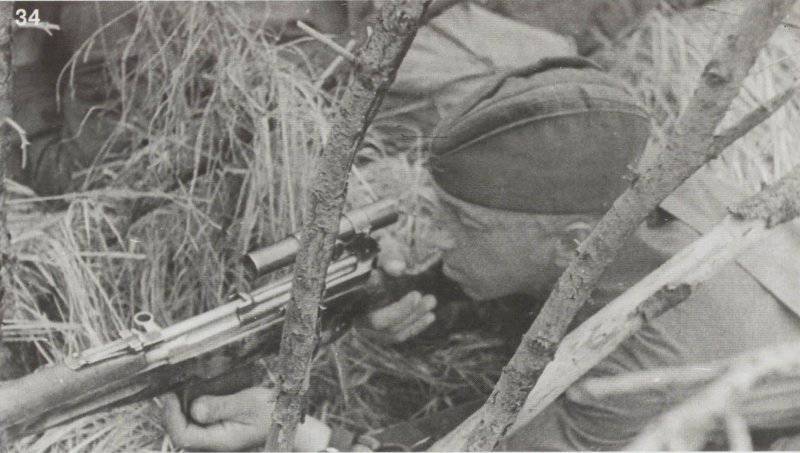
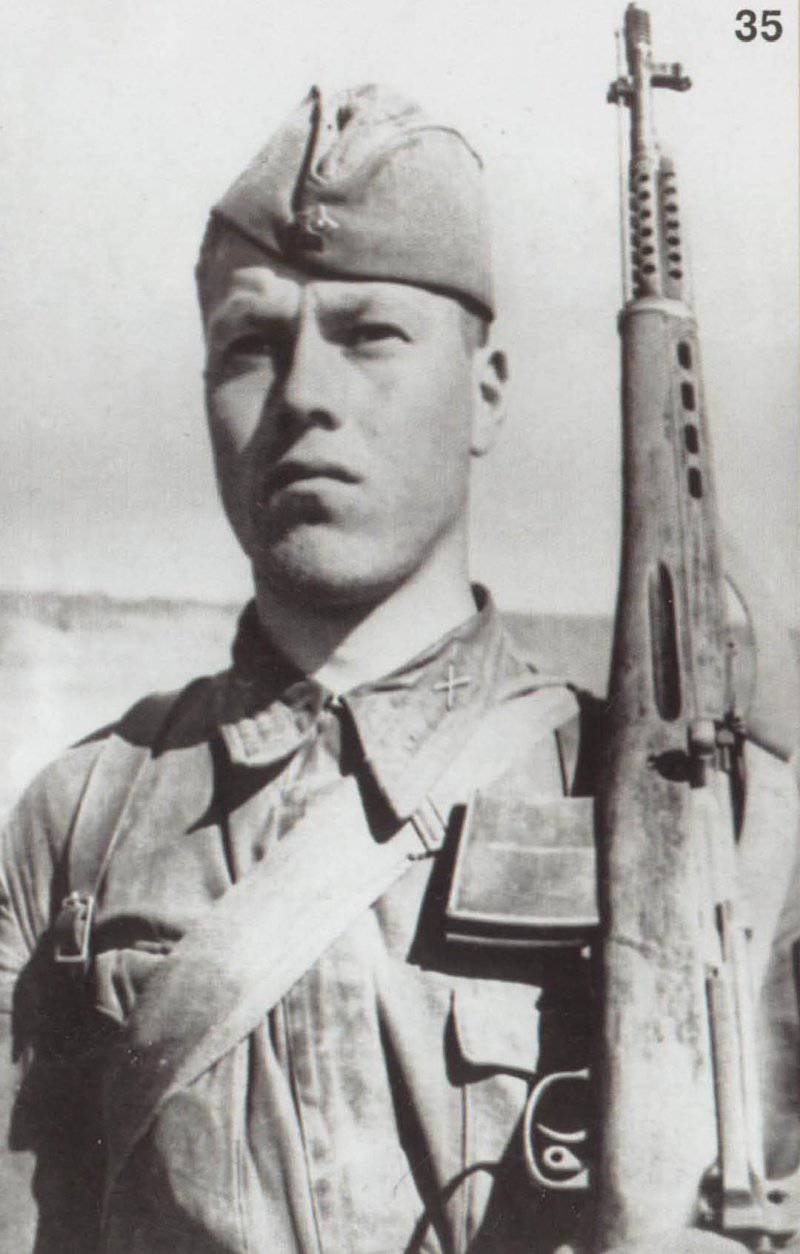
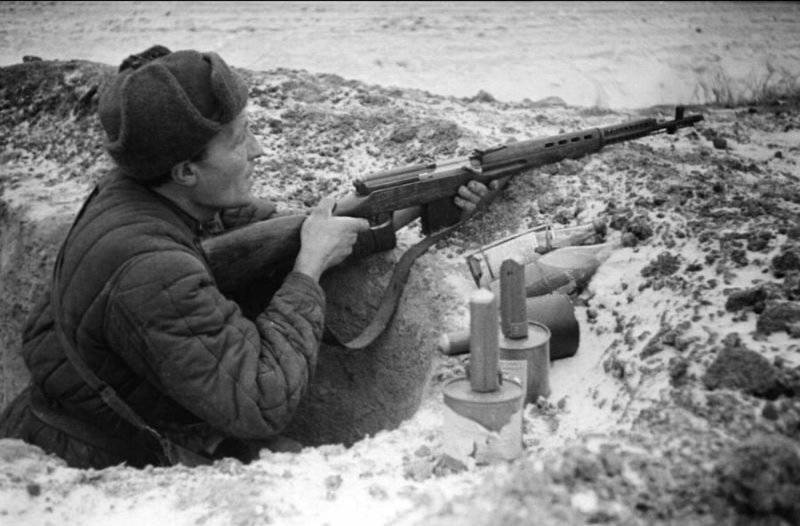
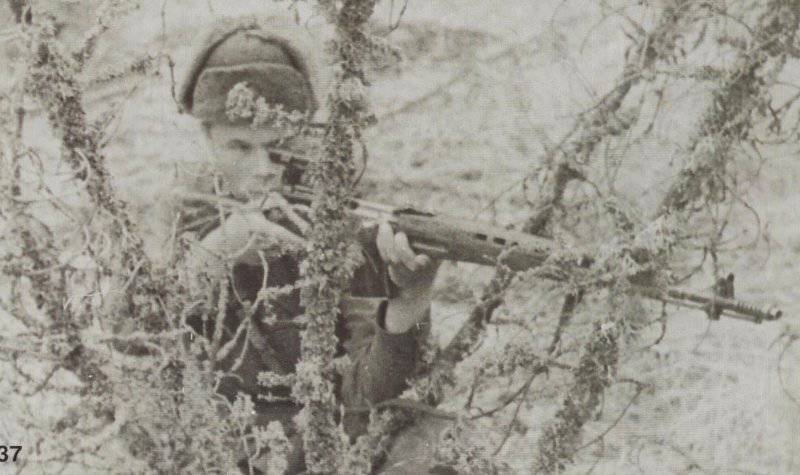
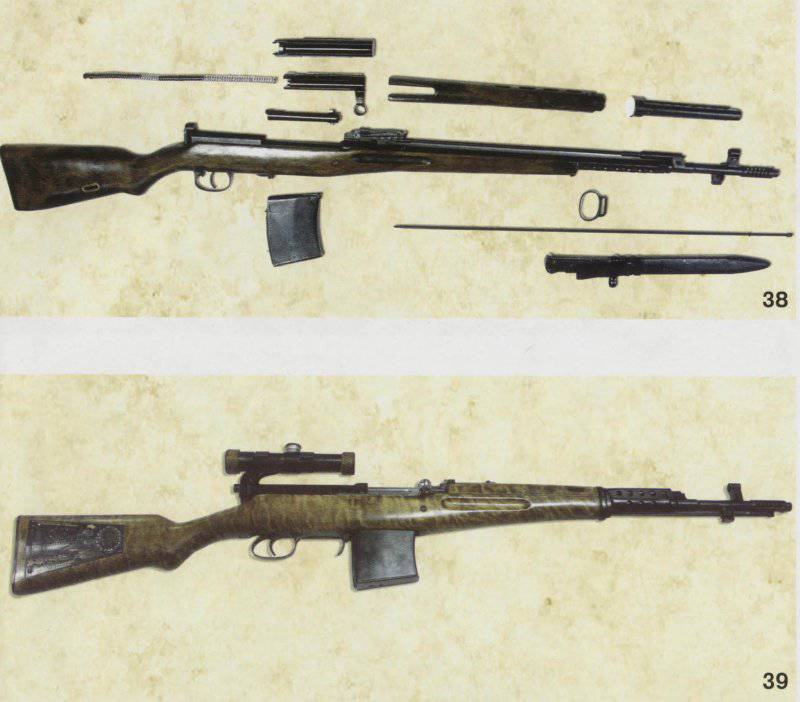
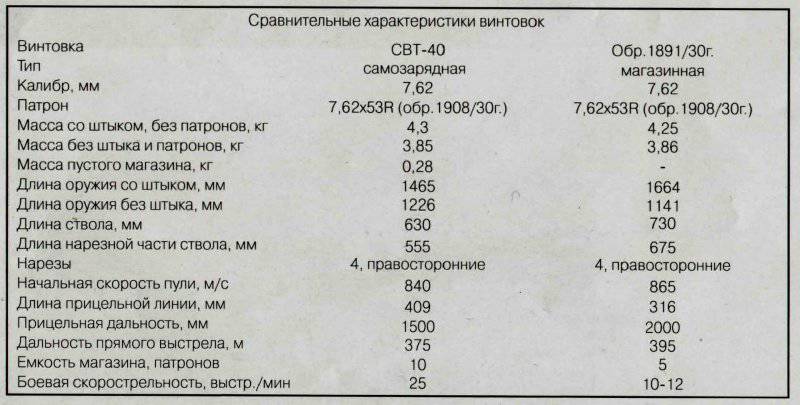
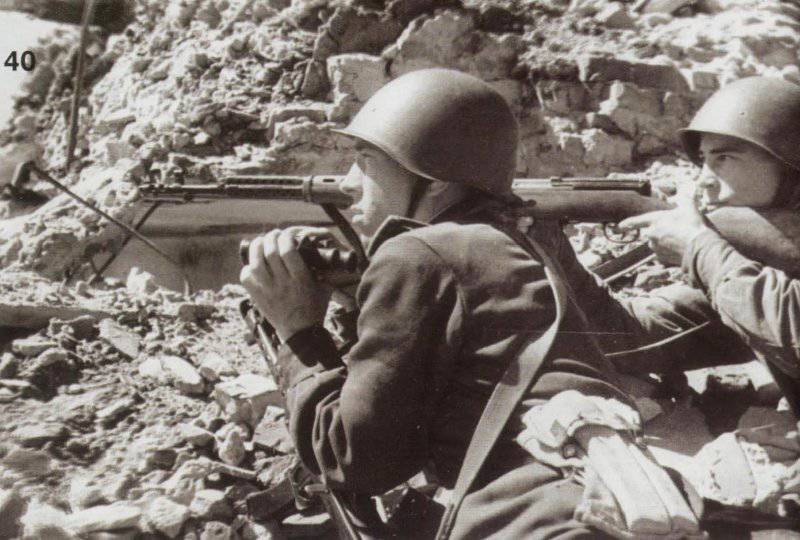
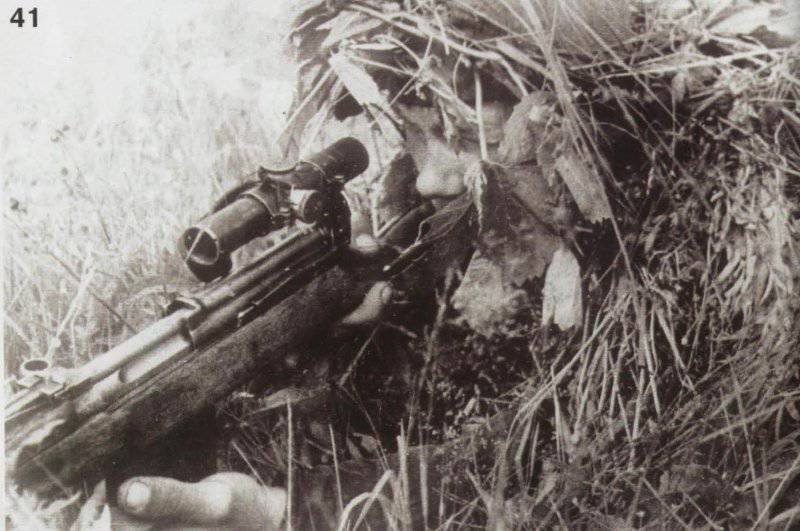
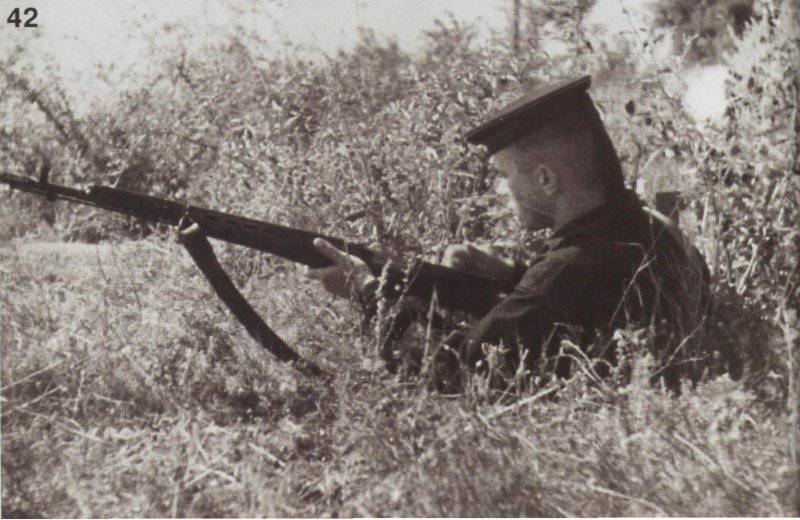
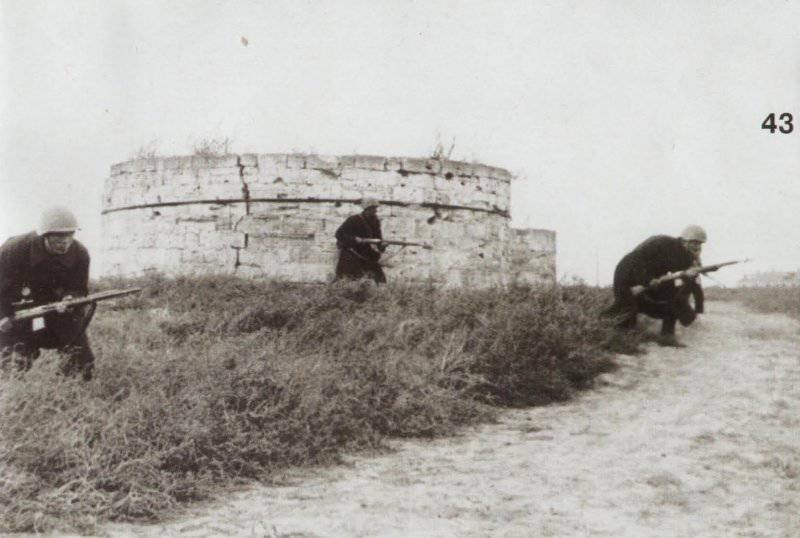
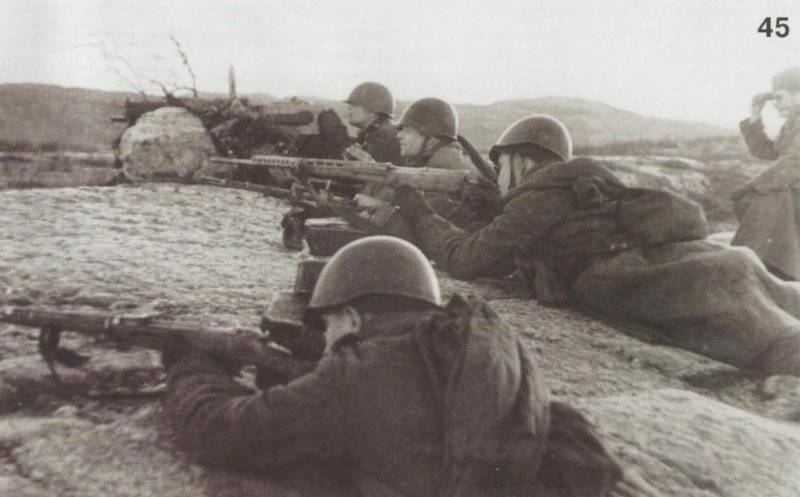
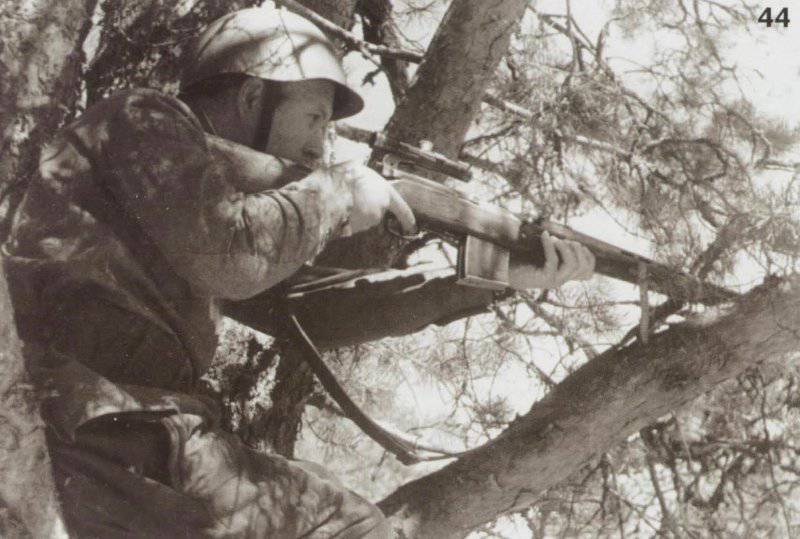
Information